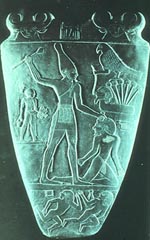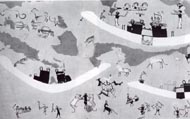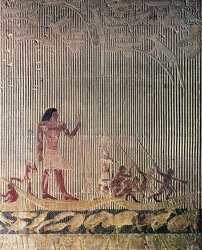Relief- sculpture which is not freestanding, but is carved or cast so that it projects from a surface of which it is part. The degree of projection is described as high or low relief, high relief being almost detached from the surface and low relief being only slightly raised.
Hierarchic Scaling- when certain figures are presented as larger in scale than others because of their relative importance within a social or religious hierarchy.
Conceptual approach- representing what one knows to be true of an object.
Perceptual approach- representing what one can see from a particular vantage point.
Web Sites

|

|
| Palette of Narmer, c. 3000 B.C.. Early Dynastic Period. | Painting from a shrine at Hierakonpolis, c. 3500 B.C., Pre-Dynastic Period. |
Narmer's palette has been presented by some art historians as the first historic work of art as opposed to pre-historic antecedents. Through a comparison of these two works of art define essential differences in the manner of presentation of these two works of art.

|

|
| Palette of Narmer, c. 3000 B.C. | Hippotamus Hunt of Ti, c. 2400 B.C. |
Narmer's palette has been characterized as a "blue-print" of figure representation in Egyptian art. Demonstrate this by comparing these two monuments.